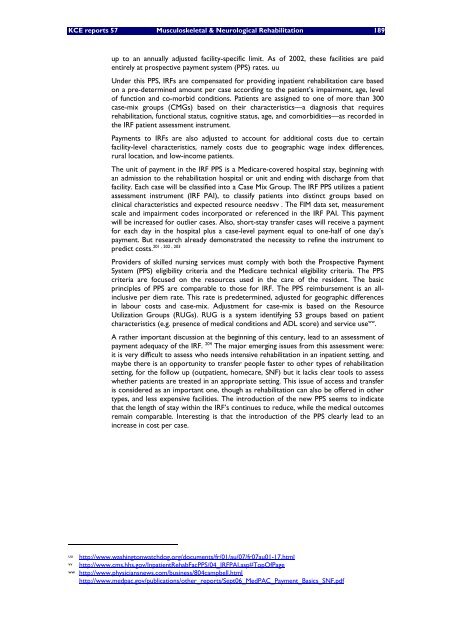The report is available in English with a French summary - KCE
The report is available in English with a French summary - KCE
The report is available in English with a French summary - KCE
You also want an ePaper? Increase the reach of your titles
YUMPU automatically turns print PDFs into web optimized ePapers that Google loves.
<strong>KCE</strong> <strong>report</strong>s 57 Musculoskeletal & Neurological Rehabilitation 189<br />
up to an annually adjusted facility-specific limit. As of 2002, these facilities are paid<br />
entirely at prospective payment system (PPS) rates. uu<br />
Under th<strong>is</strong> PPS, IRFs are compensated for provid<strong>in</strong>g <strong>in</strong>patient rehabilitation care based<br />
on a pre-determ<strong>in</strong>ed amount per case accord<strong>in</strong>g to the patient’s impairment, age, level<br />
of function and co-morbid conditions. Patients are assigned to one of more than 300<br />
case-mix groups (CMGs) based on their character<strong>is</strong>tics—a diagnos<strong>is</strong> that requires<br />
rehabilitation, functional status, cognitive status, age, and comorbidities—as recorded <strong>in</strong><br />
the IRF patient assessment <strong>in</strong>strument.<br />
Payments to IRFs are also adjusted to account for additional costs due to certa<strong>in</strong><br />
facility-level character<strong>is</strong>tics, namely costs due to geographic wage <strong>in</strong>dex differences,<br />
rural location, and low-<strong>in</strong>come patients.<br />
<strong>The</strong> unit of payment <strong>in</strong> the IRF PPS <strong>is</strong> a Medicare-covered hospital stay, beg<strong>in</strong>n<strong>in</strong>g <strong>with</strong><br />
an adm<strong>is</strong>sion to the rehabilitation hospital or unit and end<strong>in</strong>g <strong>with</strong> d<strong>is</strong>charge from that<br />
facility. Each case will be classified <strong>in</strong>to a Case Mix Group. <strong>The</strong> IRF PPS utilizes a patient<br />
assessment <strong>in</strong>strument (IRF PAI), to classify patients <strong>in</strong>to d<strong>is</strong>t<strong>in</strong>ct groups based on<br />
cl<strong>in</strong>ical character<strong>is</strong>tics and expected resource needsvv . <strong>The</strong> FIM data set, measurement<br />
scale and impairment codes <strong>in</strong>corporated or referenced <strong>in</strong> the IRF PAI. Th<strong>is</strong> payment<br />
will be <strong>in</strong>creased for outlier cases. Also, short-stay transfer cases will receive a payment<br />
for each day <strong>in</strong> the hospital plus a case-level payment equal to one-half of one day’s<br />
payment. But research already demonstrated the necessity to ref<strong>in</strong>e the <strong>in</strong>strument to<br />
201 , 202 , 203<br />
predict costs.<br />
Providers of skilled nurs<strong>in</strong>g services must comply <strong>with</strong> both the Prospective Payment<br />
System (PPS) eligibility criteria and the Medicare technical eligibility criteria. <strong>The</strong> PPS<br />
criteria are focused on the resources used <strong>in</strong> the care of the resident. <strong>The</strong> basic<br />
pr<strong>in</strong>ciples of PPS are comparable to those for IRF. <strong>The</strong> PPS reimbursement <strong>is</strong> an all<strong>in</strong>clusive<br />
per diem rate. Th<strong>is</strong> rate <strong>is</strong> predeterm<strong>in</strong>ed, adjusted for geographic differences<br />
<strong>in</strong> labour costs and case-mix. Adjustment for case-mix <strong>is</strong> based on the Resource<br />
Utilization Groups (RUGs). RUG <strong>is</strong> a system identify<strong>in</strong>g 53 groups based on patient<br />
character<strong>is</strong>tics (e.g. presence of medical conditions and ADL score) and service use ww .<br />
A rather important d<strong>is</strong>cussion at the beg<strong>in</strong>n<strong>in</strong>g of th<strong>is</strong> century, lead to an assessment of<br />
payment adequacy of the IRF. 204 <strong>The</strong> major emerg<strong>in</strong>g <strong>is</strong>sues from th<strong>is</strong> assessment were:<br />
it <strong>is</strong> very difficult to assess who needs <strong>in</strong>tensive rehabilitation <strong>in</strong> an <strong>in</strong>patient sett<strong>in</strong>g, and<br />
maybe there <strong>is</strong> an opportunity to transfer people faster to other types of rehabilitation<br />
sett<strong>in</strong>g, for the follow up (outpatient, homecare, SNF) but it lacks clear tools to assess<br />
whether patients are treated <strong>in</strong> an appropriate sett<strong>in</strong>g. Th<strong>is</strong> <strong>is</strong>sue of access and transfer<br />
<strong>is</strong> considered as an important one, though as rehabilitation can also be offered <strong>in</strong> other<br />
types, and less expensive facilities. <strong>The</strong> <strong>in</strong>troduction of the new PPS seems to <strong>in</strong>dicate<br />
that the length of stay <strong>with</strong><strong>in</strong> the IRF’s cont<strong>in</strong>ues to reduce, while the medical outcomes<br />
rema<strong>in</strong> comparable. Interest<strong>in</strong>g <strong>is</strong> that the <strong>in</strong>troduction of the PPS clearly lead to an<br />
<strong>in</strong>crease <strong>in</strong> cost per case.<br />
uu http://www.wash<strong>in</strong>gtonwatchdog.org/documents/fr/01/au/07/fr07au01-17.html<br />
vv http://www.cms.hhs.gov/InpatientRehabFacPPS/04_IRFPAI.asp#TopOfPage<br />
ww http://www.physiciansnews.com/bus<strong>in</strong>ess/804campbell.html<br />
http://www.medpac.gov/publications/other_<strong>report</strong>s/Sept06_MedPAC_Payment_Basics_SNF.pdf

















